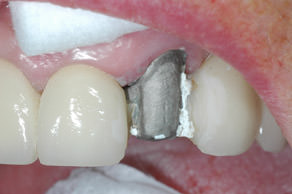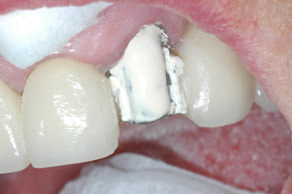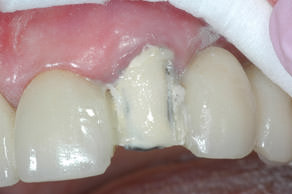This case highlights one of the problems associated with long span fixed bridges. This particular bridge is a 6 unit bridge that extends from the front tooth on the left all the way to the back tooth on the same side. It is a bridge that has been in place for quite a few years and is doing reasonably well but has suffered a porcelain fracture on one of the front support teeth. This type of fracture does not affect the overall strength of the bridge and does not reduce its ability to function but clearly has an aesthetic impact. Both of the front support teeth have been root canal treated and are restored with cast metal posts meaning that they are rather fragile teeth and at risk of fracture if we attempt to remove the bridge. Clearly we could redo the whole bridge but this represents a major commitment in time and cost for the patient who, understandably, is keen to avoid this.
The technique shown utilises modern metal and ceramic primers to try and gain enhanced bonding between a direct composite “veneer” that is built up in the mouth. The metal is first roughened with a “sandblaster” or “microetcher” to increase the surface area and encourage greater bonding. Next the metal and ceramic primers are used to try and enhance chemical bonding between the composite and the bridge. A layer of “opaquer” is used next to block out the grey of the metal and this is then followed by a layer of fibre reinforced mesh which is designed to help resist the tensile forces acting upon the repair. After this stage it is a relatively simple process to coat on various layers of composite filling material to build up the “veneer”.
Although the aesthetics achieved with this technique can be very pleasing it should be stressed that this sort of result is unpredictable in prognosis as the chemistry involved in the primers does not produce great bond strengths and the tensile forces that caused the fracture in the first place are likely to continue to act upon the repair. The technique is time consuming and the primers expensive meaning that repairs can attract a significant fee although these will be only a fraction of the likely replacement costs. Whenever I do a repair such as this I say that we are delaying the next stage but should also be planning for it as I do expect further fractures to occur. That said the delay that it gives us can be valuable particularly when such a fracture has occurred at a most inconvenient time, as they always seem to do!




If you have concerns over any of your bridge work then please do not hesitate to call the surgery on 01580752202 and we will be happy to help.